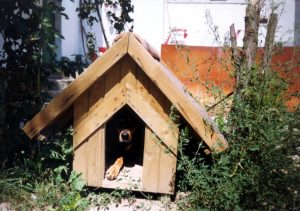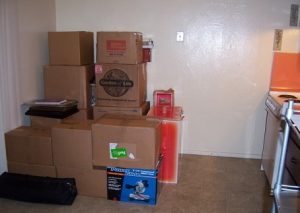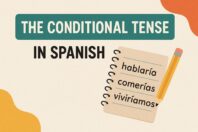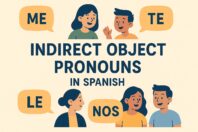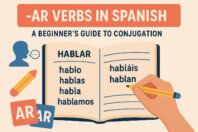Spanish Prepositions: How to Say Where Something is in Spanish (Next to, Above, Behind)
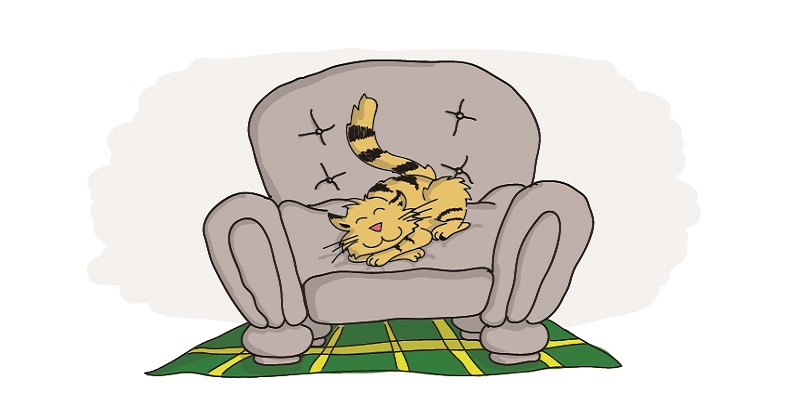
Get our free email course, Shortcut to Conversational.
Have conversations faster, understand people when they speak fast, and other tested tips to learn faster.
More infoImagine you’re calling a cab and need to tell them where you are. “I’m in front of the mall” you want to say, but you’re not sure how to say “in front of”. You’re looking for a Spanish preposition.
In front of, next to, above, below, behind, etc. – these are core parts of language. In this post, we’ll cover the most common Spanish prepositions and some example uses.
Dentro de (in)
This is for when one object is inside of another.
- Los zapatos están dentro de la caja. (The shoes are inside the box.)
- Las llaves están dentro del bolso. (The keys are inside the bag.)
- Los niños están dentro de la escuela. (The boys are in the school.)
Sobre (on)
This is when something is on top of (touching) another object.
- El gato está sobre el sofá. (The cat is on the sofa.)
- La comida está sobre la mesa. (The food is on the table)
- La almohada está sobre la cama. (The pillow is on the bed.)
Al lado de (next to)
This is when something is next to another object. The literal translation is “to the side of”.
- Yo estoy al lado de tu casa. (I’m next to your home.)
- Los niños están al lado de la heladería. (The boys are next to the ice cream store.)
- Ana está al lado de Álvaro. (Ana is next to Alvaro.)
En frente de (in front of)
This is when something is in front of an object or place.
- Ana está en frente de la chimenea. (Ana is in front of the chimney.)
- Estoy en frente del centro comercial. (I’m in front of the mall.)
Detrás (behind)
This is when something is behind another object or place.
- Los actores están detrás de la pantalla. (The actors are behind the screen.)
- Los huevos están detrás de la mantequilla. (The eggs are behind the butter.)
- Estoy detrás tuyo. (I’m behind you.)
Debajo (under)
This is when something is under something else – whether you can see it or not.
- Nosotros estamos debajo de la sombrilla. (We’re under the umbrella.)
- Kai tiene una camisa azul debajo de su chaqueta. (Kai has a blue shirt under his jacket.)
- Los zapatos están debajo de la cama. (The shoes are under the bed.)
Entre/en medio de (between)
This is used when an object is placed in the middle of other objects.
En medio de is only for when there are two objects (not more). But, we can use entre for both two and more than two objects.
- Tú estás entre dos carros. (You’re between two cars.)
- Hay un autobús en medio de la calle. (There’s a bus in the middle of the street.)
- Debo decidir entre ir al cine o ir a bailar. (I need to decide between going to the movie theater and dancing.)
En la esquina (on the corner)
This is when something or someone is on the corner of something (usually a street).
- El restaurante está en la esquina. (The restaurant is on the corner.)
- Te espero en la esquina. (I’ll wait for you on the corner.)
- Para llegar a la tienda debes llegar a la esquina y cruzar la calle. (To arrive at the store, you must arrive at the corner and cross the street.)
Spanish Prepositions Quiz
1. La bebé está _______ de sus padres.
2. El perro está ______________ de la perrera.
3. La perrera está __________ de la casa.
4. La pelota está __________ del perro.
5. El perro está ___________ de la pelota.
6. Ella está _________________ de la mesa.
7. Ella está _________________ del piso.
8. Las cajas están en la _____________ de la bodega.
9. El gato está ____________ de dos perros.
10.El gato y los perros están ___________ el sofá.
Key:
- entre
- dentro
- fuera
- en frente del perro
- detrás de la pelota
- debajo de la mesa
- encima del piso
- esquina de la bodega
- en medio de dos perros
- sobre el sofá
For more free practice, click here to get our private flashcards.

